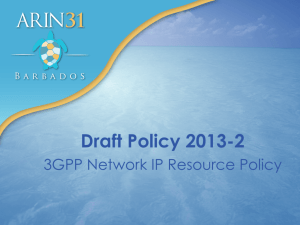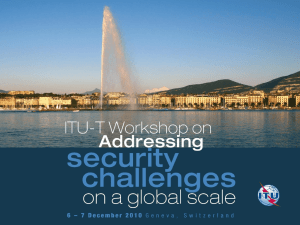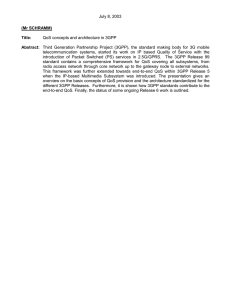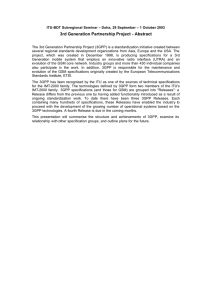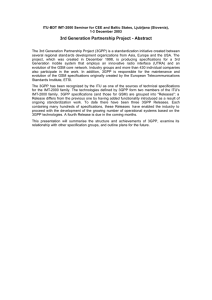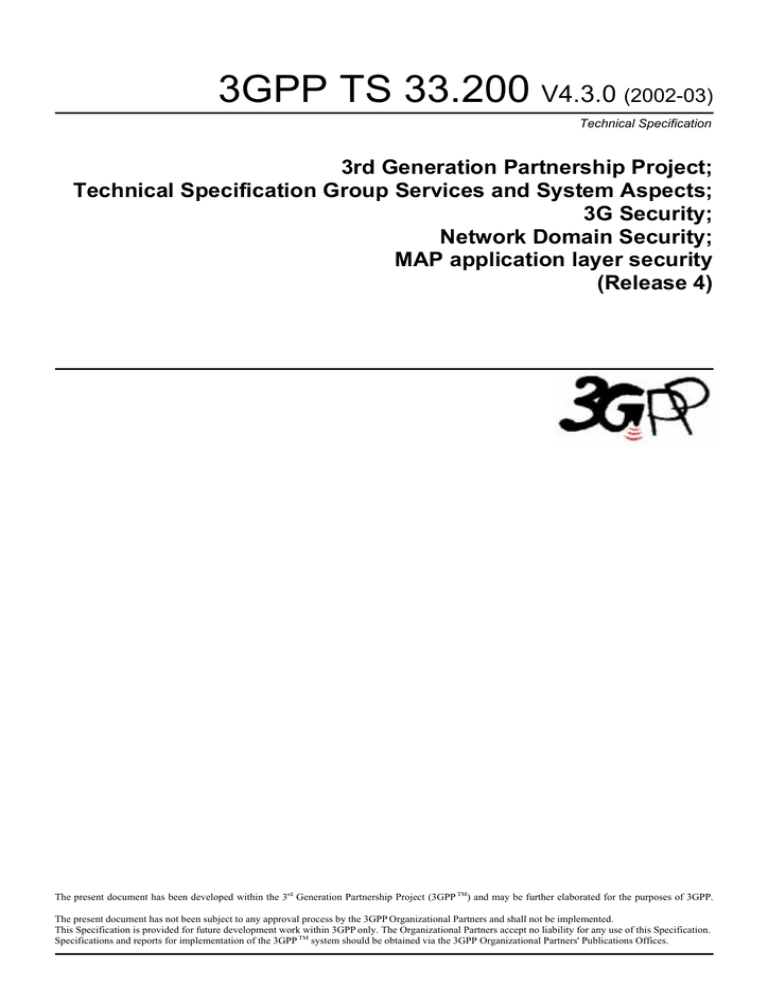
3GPP TS 33.200 V4.3.0 (2002-03)
Technical Specification
3rd Generation Partnership Project;
Technical Specification Group Services and System Aspects;
3G Security;
Network Domain Security;
MAP application layer security
(Release 4)
The present document has been developed within the 3rd Generation Partnership Project (3GPP TM) and may be further elaborated for the purposes of 3GPP.
The present document has not been subject to any approval process by the 3GPP Organizational Partners and shall not be implemented.
This Specification is provided for future development work within 3GPP only. The Organizational Partners accept no liability for any use of this Specification.
Specifications and reports for implementation of the 3GPP TM system should be obtained via the 3GPP Organizational Partners' Publications Offices.
Release 4
2
3GPP TS 33.200 V4.3.0 (2002-03)
Keywords
Security, Core Network, MAP, Key management
3GPP
Postal address
3GPP support office address
650 Route des Lucioles - Sophia Antipolis
Valbonne - FRANCE
Tel.: +33 4 92 94 42 00 Fax: +33 4 93 65 47 16
Internet
http://www.3gpp.org
Copyright Notification
No part may be reproduced except as authorized by written permission.
The copyright and the foregoing restriction extend to reproduction in all media.
© 2002, 3GPP Organizational Partners (ARIB, CWTS, ETSI, T1, TTA,TTC).
All rights reserved.
3GPP
Release 4
3
3GPP TS 33.200 V4.3.0 (2002-03)
Contents
Foreword............................................................................................................................................................ 4
Introduction........................................................................................................................................................ 4
1
Scope ....................................................................................................................................................... 5
2
References ............................................................................................................................................... 5
3
Definitions, symbols and abbreviations................................................................................................... 5
3.1
3.2
3.3
3.4
Definitions ...............................................................................................................................................................5
Symbols ...................................................................................................................................................................6
Abbreviations...........................................................................................................................................................6
Conventions .............................................................................................................................................................6
4
Principles of MAP application layer security .......................................................................................... 7
5
MAP security (MAPsec) ......................................................................................................................... 7
5.1
Security services provided by MAPsec ...................................................................................................................7
5.2
Properties and tasks of MAPsec enabled network elements ....................................................................................7
5.3
Policy requirements for the MAPsec Security Policy Database (SPD) .................................................................8
5.4
MAPsec security association attribute definition.....................................................................................................8
5.5
MAPsec structure of protected messages.................................................................................................................9
5.5.1
MAPsec security header...................................................................................................................................10
5.5.2
Protected payload .............................................................................................................................................10
5.5.2.1
Protection Mode 0 ............................................................................................................................................10
5.5.2.2
Protection Mode 1 ............................................................................................................................................10
5.5.2.3
Protection Mode 2 ............................................................................................................................................11
5.6
MAPsec algorithms................................................................................................................................................11
5.6.1
Mapping of MAPsec-SA encryption algorithm identifiers ..............................................................................11
5.6.1.1
Description of MEA-1......................................................................................................................................11
5.6.2
Mapping of MAPsec-SA integrity algorithm identifiers ..................................................................................11
5.6.2.1
Description of MIA-1.......................................................................................................................................11
5.6.3
Construction of IV............................................................................................................................................12
6
MAPsec protection profiles ................................................................................................................... 12
6.1
Granularity of protection........................................................................................................................................12
6.2
MAPsec protection groups.....................................................................................................................................12
6.2.1
MAPsec protection groups ...............................................................................................................................12
6.2.1.1
MAP-PG(0) – No Protection............................................................................................................................12
6.2.1.2
MAP-PG(1) – Protection for Reset ..................................................................................................................13
6.2.1.3
MAP-PG(2) – Protection for Authentication Information except Handover Situations...................................13
6.2.1.4
MAP-PG(3) – Protection for Authentication Information in Handover Situations..........................................13
6.2.1.5
MAP-PG(4) – Protection of non location dependant HLR data.......................................................................14
6.3
MAPsec protection profiles ...................................................................................................................................14
Annex A (informative):
Guidelines for manual key management..................................................... 15
A.1
Inter-domain Security Association and Key Management Procedures ................................................. 15
A.2
Local Security Association Distribution................................................................................................ 15
Annex B (normative):
MAPsec message flows.................................................................................. 16
Annex C (informative):
Change history............................................................................................... 19
3GPP
Release 4
4
3GPP TS 33.200 V4.3.0 (2002-03)
Foreword
This Technical Specification has been produced by the 3rd Generation Partnership Project (3GPP).
The contents of the present document are subject to continuing work within the TSG and may change following formal
TSG approval. Should the TSG modify the contents of the present document, it will be re-released by the TSG with an
identifying change of release date and an increase in version number as follows:
Version x.y.z
where:
x the first digit:
1 presented to TSG for information;
2 presented to TSG for approval;
3 or greater indicates TSG approved document under change control.
y the second digit is incremented for all changes of substance, i.e. technical enhancements, corrections, updates,
etc.
z the third digit is incremented when editorial only changes have been incorporated in the document.
Introduction
The absence of security in Signalling System No. 7 (SS7) networks is an identified security weakness in 2G systems.
This was formerly perceived not to be a problem, since the SS7 networks were the provinces of a small number of large
institutions. This is no longer the case, and so there is now a need for security precautions.
For 3G systems it is a clear goal to be able to protect the core network signalling protocols, and by implication this
means that security solutions must be found for both SS7 and IP based protocols.
Various protocols and interfaces are used for control plane signalling within and between core networks. The security
services that have been identified as necessary are confidentiality, integrity, authentication and anti-replay protection.
These will be ensured by standard procedures, based on cryptographic techniques.
3GPP
Release 4
1
5
3GPP TS 33.200 V4.3.0 (2002-03)
Scope
This technical specification covers the security mechanisms and procedures necessary to protect the MAP protocol. The
complete set of enhancements and extensions to facilitate security protection for the MAP protocol is termed MAPsec
and it covers transport security in the MAP protocol itself and the security management procedures.
The security mechanisms specified for MAP are on the application layer. This means that MAPsec is independent of the
network and transport protocols to be used.
This technical specification contains the stage-2 specification for security protection of the MAP protocol. The actual
implementation (stage-3) specification can be found in the MAP stage-3 specification, TS 29.002 [4].
NOTE:
2
It is explicitly noted that automated key management and key distribution is not part of Rel-4. All key
management and key distribution in Rel-4 must therefore be carried out by other means. (See Annex A)
References
The following documents contain provisions which, through reference in this text, constitute provisions of the present
document.
• References are either specific (identified by date of publication, edition number, version number, etc.) or
non-specific.
• For a specific reference, subsequent revisions do not apply.
• For a non-specific reference, the latest version applies. In the case of a reference to a 3GPP document
(including a GSM document), a non-specific reference implicitly refers to the latest version of that document in
the same Release as the present document.
[1]
3G TS 21.133: Security Threats and Requirements.
[2]
3G TS 21.905: 3G Vocabulary.
[3]
3G TS 23.060: General Packet Radio Service (GPRS); Service description; Stage 2.
[4]
3G TS 29.002: Mobile Application Part (MAP) specification.
[5]
NIST Special Publication 800-38A "Recommendation for Block Cipher Modes of Operation"
December 2001.
[6]
ISO/IEC 9797: "Information technology -- Security techniques -- Message Authentication Codes
(MACs) -- Part 1: Mechanisms using a block cipher", Ed.1, 1999-12-16.
[7]
FIPS Publication 197: "Specification for the Advanced Encryption Standard (AES)", November 26,
2001.
3
Definitions, symbols and abbreviations
3.1
Definitions
For the purposes of the present document, the following terms and definitions apply.
Anti-replay protection: Anti-replay protection is a special case of integrity protection. Its main service is to protect
against replay of self-contained packets that already have a cryptographical integrity mechanism in place.
Confidentiality: The property that information is not made available or disclosed to unauthorised individuals, entities
or processes.
3GPP
Release 4
6
3GPP TS 33.200 V4.3.0 (2002-03)
Data integrity: The property that data has not been altered in an unauthorised manner.
Data origin authentication: The corroboration that the source of data received is as claimed.
Entity authentication: The provision of assurance of the claimed identity of an entity.
Key freshness: A key is fresh if it can be guaranteed to be new, as opposed to an old key being reused through actions
of either an adversary or authorised party.
Security Association: A logical connection created for security purposes. All traffic traversing a security association is
provided the same security protection. The security association specifies protection levels, algorithms to be used,
lifetimes of the connection etc.
MAPsec: The complete collection of protocols and procedures needed to protect MAP messages. MAPsec can be
divided into three main parts. These are (1) MAPsec transport security, (2) MAPsec Local Security Association
distribution and (3) MAPsec Inter-domain Security Association and Key Management procedures.
3.2
Symbols
For the purposes of the present document, the following symbols apply:
f6
f7
Zf
3.3
MAP encryption algorithm.
MAP integrity algorithm.
The MAP application layer security interface between MAP-NEs engaged in security protected
signalling.
Abbreviations
For the purposes of the present document, the following abbreviations apply:
AES
FALLBACK
IP
IV
MEK
MAC
MAC-M
MAP
MAP-NE
MAPsec
MEA
MIA
MIK
NDS
NE
PPI
PPRI
PROP
SA
SADB
SPD
SPI
TVP
3.4
Advanced Encryption Standard
Fallback to unprotected mode indicator
Internet Protocol
Initialisation Vector
MAP Encryption Key
Message Authentication Code
MAC used for MAP
Mobile Application Part
MAP Network Element
MAP security – the MAP security protocol suite
MAP Encryption Algorithm identifier
MAP Integrity Algorithm identifier
MAP Integrity Key
Network Domain Security
Network Entity
Protection Profile Indicator
Protection Profile Revision Identifier
Proprietary field
Security Association
Security Association DataBase
Security Policy Database (sometimes also referred to as SPDB)
Security Parameters Index
Time Variant Parameter
Conventions
All data variables in this specification are presented with the most significant substring on the left hand side and the
least significant substring on the right hand side. A substring may be a bit, byte or other arbitrary length bitstring.
Where a variable is broken down into a number of substrings, the leftmost (most significant) substring is numbered 0,
the next most significant is numbered 1, and so on through to the least significant.
3GPP
Release 4
4
7
3GPP TS 33.200 V4.3.0 (2002-03)
Principles of MAP application layer security
This technical specification defines mechanisms for protecting the MAP protocol at the application layer. The MAP
protocol may also be protected at the network layer when IP is used as the transport protocol. However, whenever interworking with networks using SS7-based transport is necessary, protection at the application layer shall be used.
The security measures specified in this TS are only fully useful if all interconnected operators use them. In order to
prevent active attacks all interconnected operators must at least use MAPsec with the suitable protection levels as
indicated in this specification and treat the reception of all MAP messages (protected and unprotected) in a uniform way
in the receiving direction.
Before protection can be applied, Security Associations (SA) needs to be established between the respective MAP
network elements. Security associations define, among other things, which keys, algorithms, and protection profiles to
use to protect MAP signalling. The necessary MAPsec-SAs between networks are negotiated between the respective
network operators. The negotiated SA will be effective PLMN-wide and distributed to all network elements which
implement MAP application layer security within the PLMN. Signalling traffic protected at the application layer will,
for routing purposes, be indistinguishable from unprotected traffic to all parties except for the sending and receiving
entities.
Protection at the application layer implies changes to the application protocol itself to allow for the necessary security
functionality to be added.
The MAP application layer security interface between MAP-NEs engaged in security protected signalling is referred to
in this specification as the Zf interface. The interface applies to all MAPsec transactions, intra- or inter-PLMN.
Annex B includes detailed procedures on how secure MAP signalling is performed between two MAP-NEs.
5
MAP security (MAPsec)
5.1
Security services provided by MAPsec
The security services provided by MAPsec are:
-
data integrity;
-
data origin authentication;
-
anti-replay protection;
-
confidentiality (optional).
5.2
Properties and tasks of MAPsec enabled network elements
MAPsec MAP-NEs shall maintain the following databases:
-
NE-SPD-MAP: A database in an NE containing MAP security policy information (see clause 5.3);
-
NE-SADB-MAP: A database in an NE containing MAPsec-SA information. MAP-NEs shall monitor the SA
hard expiry time and expired SAs shall be deleted from the database (see clause 5.4).
MAPsec MAP-NEs shall be able to perform the following operations:
-
Secure MAP signalling (i.e. send/receive protected or unprotected messages) according to information in NESPD-MAP and NE-SADB-MAP. The structure of protected messages is defined in clause 5.5 and the protection
algorithms are defined in clause 5.6.
3GPP
Release 4
5.3
8
3GPP TS 33.200 V4.3.0 (2002-03)
Policy requirements for the MAPsec Security Policy
Database (SPD)
The security policies for MAPsec key management are specified in the NE’s SPD. SPD entries define which MAP
operation components are protected and which MAP SAs (if any) to use to protect MAP signalling based on the PLMN
of the peer NE. There can be no local security policy definitions for individual NEs. Instead, SPD entries of different
NE within the same PLMN shall be identical.
Fallback to unprotected mode:
-
The "fallback to unprotected mode" (enabled/disabled) shall be available to the MAP-NE before any
communication towards other MAP-NEs can take place. For the receiving direction, it is sufficient to have a
single parameter indicating whether fallback for incoming messages is allowed or not. For the sending direction,
the information should indicate for each destination PLMN whether fallback for outgoing messages is allowed or
not;
-
The use of the fallback indicators is specified in Annex B;
-
The security measures specified in this TS are only fully useful for a particular PLMN if it disallows fallback to
unprotected mode for MAP messages received from any other PLMN.
Table of MAPsec operation components:
-
The security policy database (SPD) shall contain a table of MAPsec operation components for incoming
messages. This table contains operation components which have to be carried in MAPsec messages with
Protection Mode 1 or 2. The use of MAPsec operation components is specified in Annex B.
Uniformity of protection profiles:
-
In order to ensure full protection, a particular PLMN shall use the same protection profile for incoming MAPsec
messages from all other PLMNs. In particular, full protection is not ensured when protection profile A (no
protection) is used for some source PLMNs and other profiles are used for other source PLMNs.
Explicit policy configuration:
-
The SPD shall contain an entry for each PLMN the MAP-NE is allowed to communicate with.
Editor’s note: Some issues need to be investigated: Non-synchronised expiration times issue, mechanism to
distinguish inbound/outbound SPDs ?
5.4
MAPsec security association attribute definition
The MAPsec security association shall contain the following data elements:
-
Destination PLMN-Id:
PLMN-Id is the ID number of the receiving Public Land Mobile Network (PLMN). The value for the PLMN-Id
is a concatenation of the Mobile Country Code (MCC) and Mobile Network Code (MNC) of the receiving
network.
-
Security Parameters Index (SPI):
SPI is a 32-bit value that is used in combination with Destination PLMN-Id to uniquely identify a MAPsec-SA.
-
Sending PLMN-Id:
PLMN-Id is the ID number of the sending Public Land Mobile Network (PLMN). The value for the PLMN-Id is
a concatenation of the Mobile Country Code (MCC) and Mobile Network Code (MNC) of the sending network.
-
MAP Encryption Algorithm identifier (MEA):
Identifies the encryption algorithm. Mode of operation of algorithm is implicitly defined by the algorithm
identifier. Mapping of algorithm identifiers is defined in clause 5.6.
3GPP
Release 4
-
9
3GPP TS 33.200 V4.3.0 (2002-03)
MAP Encryption Key (MEK):
Contains the encryption key. Length is defined according to the algorithm identifier.
-
MAP Integrity Algorithm identifier (MIA):
Identifies the integrity algorithm. Mode of operation of algorithm is implicitly defined by the algorithm identifier.
Mapping of algorithm identifiers is defined in section 5.6.
-
MAP Integrity Key (MIK):
Contains the integrity key. Length is defined according to the algorithm identifier.
-
Protection Profile Revision Identifier (PPRI):
Contains the revision number of the PPI. Length is 8 bits. PPRI-values are defined in section 6.3.
-
Protection Profile Identifier (PPI):
Identifies the protection profile. Length is 16 bits. Mapping of profile identifiers is defined in section 6.
-
SA Hard Expiry Time:
Defines the actual expiry time of the SA. The hard expiry time shall be given in UTC time.
-
SA Soft Expiry Time:
Defines soft expiry time of the SA for outbound traffic. The soft expiry time shall be given in UTC time.
Editor’s Note: The exact format and length to be defined.
After the hard expiry time has been reached the SA shall no longer be used for inbound or outbound traffic. When the
soft expiry time is reached, the SA shall not be used any longer for the outbound traffic unless no other valid SA exists.
A MAPsec SA is uniquely identified by a destination PLMN-Id and a Security Parameters Index, SPI. As a
consequence, during SA creation, the SPI is always chosen by the receiving side.
If the SA is to indicate that MAPsec is not to be applied then all the algorithm attributes shall contain a NULL value.
5.5
MAPsec structure of protected messages
MAPsec provides for three different protection modes and these are defined as follows:
Protection Mode 0: No Protection
Protection Mode 1: Integrity, Authenticity
Protection Mode 2: Confidentiality, Integrity, and Authenticity
MAP operations protected by means of MAPsec consist of a Security Header and the Protected Payload. Secured MAP
messages have the following structure:
Security Header
Protected Payload
In all three protection modes, the security header is transmitted in cleartext.
In protection mode 2 providing confidentiality, the protected payload is essentially the encrypted payload of the original
MAP message. For integrity and authenticity in protection mode 1, the message authentication code is calculated on the
security header and the payload of the original MAP message in cleartext and it is included in the protected payload.
The message authentication code in protection mode 2 is calculated on the security header and the encrypted payload of
the original MAP message. In protection mode 0 no protection is offered, therefore the protected payload is identical to
the payload of the original MAP message.
3GPP
Release 4
5.5.1
10
3GPP TS 33.200 V4.3.0 (2002-03)
MAPsec security header
For Protection Mode 0, the security header is a sequence of the following data elements:
Security header
= SPI || Original component Id
For Protection Modes 1 and 2, the security header is a sequence of the following elements:
Security header
-
=
SPI || Original component Id || TVP || NE-Id || Prop
Security Parameters Index (SPI):
SPI is an arbitrary 32-bit value that is used in combination with the Destination PLMN-Id to uniquely identify a
MAPsec-SA.
-
Original component Id:
Identifies the type of component (invoke, result or error) within the MAP operation that is being securely
transported (Operation identified by operation code, Error defined by Error Code or User Information).
-
TVP:
The TVP is used for replay protection of Secured MAP operations is a 32 bit time-stamp. The receiving network
entity will accept an operation only if the time-stamp is within a certain time-window. The resolution of the
clock from which the time-stamp is derived is 0.1 seconds. The size of the time-window at the receiving network
entity is not standardised.
-
NE-Id:
6 octets used to create different IV values for different NEs within the same TVP period. It is necessary and
sufficient that NE-Id is unique per PLMN. (This is sufficient because sending keys are unique per PLMN.) The
NE-Id shall be the E.164 global title of the NE without the MCC and MNC.
-
Proprietary field (PROP):
4 octets used to create different IV values for different protected MAP messages within the same TVP period for
one NE. The usage of the proprietary field is not standardised.
5.5.2
Protected payload
5.5.2.1
Protection Mode 0
Protection Mode 0 offers no protection at all. Therefore, the protected payload of Secured MAP messages in protection
mode 0 is identical to the original MAP message payload in cleartext.
5.5.2.2
Protection Mode 1
The protected payload of Secured MAP messages in protection mode 1 takes the following form:
Cleartext|| f7(Security Header||Cleartext)
where "Cleartext" is the payload of the original MAP message in cleartext. Therefore, in Protection Mode 1 the
protected payload is a concatenation of the following information elements:
-
Cleartext
-
Message authentication code (MAC-M) calculated by the function f7
Authentication of origin and message integrity are achieved by applying the message authentication code (MAC-M)
function f7 with the integrity key defined by the security association to the concatenation of Security Header and
Cleartext. The MAC-M length shall be 32 bits.
3GPP
Release 4
5.5.2.3
11
3GPP TS 33.200 V4.3.0 (2002-03)
Protection Mode 2
The protected payload of Secured MAP Messages in protection mode 2 takes the following form:
f6( Cleartext) || f7(Security Header|| f6( Cleartext))
where "Cleartext" is the original MAP message payload in cleartext. Confidentiality is achieved by encrypting Cleartext
using the encryption function f6 with the confidentiality key defined by the security association and the initialisation
vector (IV). Authentication of origin and integrity are achieved by applying the message authentication code (MAC-M)
function f7 with the integrity key defined by the security association to the concatenation of Security Header and
ciphertext. The MAC-M length shall be 32 bits. The length of the ciphertext is the same as the length of the cleartext.
5.6
MAPsec algorithms
5.6.1
Mapping of MAPsec-SA encryption algorithm identifiers
The MEA algorithm indication fields in the MAPsec-SA are used to identify the encryption algorithm and algorithm
mode to be used. The mapping of algorithm identifiers is defined below.
Table 1: MAP encryption algorithm identifiers
MAP Encryption Algorithm
identifier
0
1
:
15
5.6.1.1
Description
Null
AES in counter mode with 128-bit key length (MANDATORY)
-not yet assigned-not yet assigned-
Description of MEA-1
The MEA-1 algorithm is AES [7] used in counter mode with a 128-bit key and 128-bit counter blocks as described in
clause 6.5 of FIPS 800-38A Recommendation for Block Cipher Modes of Operation [5]. The initial counter block T1 is
initialized with IV. Successive counter blocks Tj (J>1) are derived by applying an incrementing function over the entire
block Tj-1 (J>=2) (see Appendix B.1: The standard incrementing function of [5]).
5.6.2
Mapping of MAPsec-SA integrity algorithm identifiers
The MIA algorithm indication fields in the MAPsec-SA are used to identify the integrity algorithm and algorithm mode
to be used. The mapping of algorithm identifiers is defined below.
Table 2: MAP integrity algorithm identifiers
MAP Integrity Algorithm
identifier
0
1
:
15
5.6.2.1
Description
Null
AES in a CBC MAC mode with a 128-bit key (MANDATORY)
-not yet assigned-not yet assigned-
Description of MIA-1
The MIA-1 algorithm is the ISO/IEC 9797 Part 1: padding method 2, MAC algorithm 1 (initial transformation=1,
output transformation=1). No IV used. The MAC-length m is 32-bits (see clause 5.6.1). See ISO/IEC 9797 [6] for more
information.
3GPP
Release 4
5.6.3
12
3GPP TS 33.200 V4.3.0 (2002-03)
Construction of IV
The IV used in the encryption shall be constructed as follows:
IV
= TVP || NE-Id
|| Prop || Pad
The padding field is used to expand TVP || NE-Id || Prop to the IV length required by the cryptographic scheme in use.
The IV length shall be 16 octets. The padding (Pad) shall be 2 octets with all bits set to zero.
6
MAPsec protection profiles
6.1
Granularity of protection
MAPsec protection is specified per MAP operation component.
6.2
MAPsec protection groups
This section specifies groups of messages and their protection modes at the operation component level. Individual
protection groups or particular combinations of groups can then be used to construct protection profiles as specified in
section 6.3.
Combinations of overlapping protection groups are forbidden. Forbidden combinations are explicitly specified in 6.2.1
below.
The concept of "protection levels" is introduced to administrate the protection mode on operation component level. A
protection level of an operation determines the protection modes used for the operation's components according to the
following table.
Table 3: MAPsec protection levels
Protection
level
1
2
3
4
5
6
6.2.1
6.2.1.1
Protection mode for
invoke component
1
1
1
2
2
2
Protection mode for
result component
0
1
2
1
2
0
Protection mode for
error component
0
0
0
0
0
0
MAPsec protection groups
MAP-PG(0) – No Protection
This MAP-PP does not contain any operation and it does not protect any information. It is useful however to have a
"null" MAP-PP to use in situations where no security is required or is an option. This protection group cannot be
combined with any other protection group.
3GPP
Release 4
6.2.1.2
13
3GPP TS 33.200 V4.3.0 (2002-03)
MAP-PG(1) – Protection for Reset
Table 4: PG(1) – Protection for Reset
Application Context/Operation
Protection Level
ResetContext-v2/
Reset
ResetContext-v1/
Reset
6.2.1.3
1
1
MAP-PG(2) – Protection for Authentication Information except Handover
Situations
Table 5: PG(2) – Protection for Authentication Information except Handover Situations
Application Context/Operation
Protection Level
InfoRetrievalContext-v3/ Send
Authentication Info
InfoRetrievalContext-v2/ Send
Authentication Info
InfoRetrievalContext-v1/ Send
Parameters
InterVlrInfoRetrievalContext-v3/
Send Identification
InterVlrInfoRetrievalContext-v2/
Send Identification
6.2.1.4
3
3
3
3
3
MAP-PG(3) – Protection for Authentication Information in Handover
Situations
Table 6: PG(3) – Protection for Authentication Information in Handover Situations
Application Context/Operation
Protection Level
(Component level)
4
HandoverControlContext-v3/
Prepare Handover
(Note that the AC contains also
other operations)
HandoverControlContext-v3/
Forward Access Signalling
(Note that the AC contains also
other operations)
HandoverControlContext-v2/
Prepare Handover
(Note that the AC contains also
other operations)
HandoverControlContext-v2/
Forward Access Signalling
(Note that the AC contains also
other operations)
HandoverControlContext-v1/
Perform Handover
(Note that the AC contains also
other operations)
HandoverControlContext-v1/
Forward Access Signalling
(Note that the AC contains also
other operations)
4
4
4
4
4
3GPP
Release 4
6.2.1.5
14
3GPP TS 33.200 V4.3.0 (2002-03)
MAP-PG(4) – Protection of non location dependant HLR data
Table 7: PG(4) – Protection of non location dependant HLR data
Application Context/Operation
AnyTimeInfoHandlingContext-v3 /
AnyTimeModification
6.3
Protection Level
1
MAPsec protection profiles
Protection profiles can be individual protection groups or particular combinations of protection groups. MAP protection
profiles are coded as a 16 bit binary number where each bit corresponds to a protection group. The protection that shall
be applied to a MAPsec message is uniquely identified by the combination of PPRI and PPI.
This specification contains the MAPsec protection profiles that are identified with PPRI having value 0. Currently only
5 groups are defined, the rest are reserved for future use.
Table 8: Protection profile encoding
Protection profile bit
0
1
2
3
4
5-15
Protection group
No protection
Reset
Authentication information except handover situations
Authentication information in handover situations
Non-location dependant HLR data
Reserved
Protection profiles shall be bidirectional.
The following protection profiles are defined.
Table 9: Protection profile definition
Protection
profile
name
Profile A
Profile B
Profile C
Profile D
Profile E
Protection group
PG(0)
PG(1)
No
Reset
protection
PG(2)
AuthInfo
except
handover
situations
PG(3)
AuthInfo in
handover
situation
PG(4)
Non-location
dependant
HLR data
9
9
9
9
9
9
9
9
9
3GPP
9
9
9
9
Release 4
15
3GPP TS 33.200 V4.3.0 (2002-03)
Annex A (informative):
Guidelines for manual key management
A.1
Inter-domain Security Association and Key
Management Procedures
Manual Inter-domain Security Association and Key Management procedures is subject to roaming agreements.
Some important parts of an inter-domain Security Association and Key Management agreement is:
-
to define how to carry out the initial exchange of MAPsec SAs;
-
to define how to renew the MAPsec SAs;
-
to define how to withdraw MAPsec SAs (including requirements on how fast to execute the withdrawal);
-
to decide if fallback to unprotected mode is to be allowed;
-
to decide on key lengths, algorithms, protection profiles, and SA expiry times, etc (MAPsec SAs are expected to
be fairly long lived).
An SA being used by an NE for incoming traffic expires when it reaches its hard expiry time. When this occurs, the NE
can no longer use that SA to process incoming MAPsec traffic. If a new additional valid SA is installed into the NE, the
"old" one must still be kept by the NE until it reaches its hard expiry time, so as to be able to accept incoming traffic
still received under the "old" SA.
An SA being used by an NE for outgoing traffic expires when it reaches its soft expiry time. When this occurs, the NE
must start using another valid SA. If no such valid SA exists, the NE continues to use the "old" SA until it reaches its
hard expiry time or another valid SA effectively becomes available.
In case the current SA gets compromised, a new valid SA should be made immediately available to the NE, which
should then stop using the compromised SA and delete it.
To ease SA renewal, both PLMNs may decide to set up several MAPsec SAs in advance so that NEs can automatically
switch from one SA to another SA. In such a situation, the MAPsec SAs would have different soft and hard expiry
times.
When more than one valid SA is available, the NE chooses the one for which the soft expiry time will be reached next.
A.2
Local Security Association Distribution
Manual Local Security Association Distribution is executed entirely within one PLMN and is consequently at the
discretion of the administrative authority.
The requirement on the manual distribution procedures can be summarized as follows:
-
Procedures for transporting the relevant MAPsec SA to the MAP-NEs must be defined. In order to ensure that
the MAPsec SA are present when needed, all valid MAPsec SA should be distributed to all MAP-NEs as soon as
they are available.
-
Procedures for revocation of MAPsec SAs must be defined.
3GPP
Release 4
16
3GPP TS 33.200 V4.3.0 (2002-03)
Annex B (normative):
MAPsec message flows
Imagine a network scenario with two MAP-NEs at different PLMNs (NEa and NEb) willing to communicate using
MAPsec. Figure 1 presents the message flow.
Figure 1. MAPsec Message Flow
According to Figure 1, when MAP-NEa (NEa) from PLMN A wishes to communicate with a MAP-NEb (NEb) of
PLMN B using MAP protocol, the process is the following:
As the Sending Entity, NEa performs the following actions during the outbound processing of every MAP message:
1. NEa checks its Security Policy Database (SPD) to check if MAP security mechanisms shall be applied towards
PLMN B:
a) If the SPD does not mandate the use of MAPsec towards PLMN B, then normal MAP communication
procedures will be used and the process continues in step 4.b.
b) If the SPD mandates the use of MAPsec towards PLMN B, then the process continues at step 2.
c) If no valid entry in the SPD is found for PLMN B, then the communication is aborted and an error is returned
to the MAP user.
2. NEa checks its Security Association Database (SAD) for a valid Security Association (SA) to be used towards
PLMN B. In the case where more than one valid SA is available at the SAD, NEa shall choose the one, the soft
expiry time of which will be reached next.
a) In case protection of MAP messages towards PLMN B is not possible (e.g. no SA available, invalid SA…),
then the communication is aborted and an error is returned to MAP user.
b) If a valid SA exists but the MAP dialogue being handled does not require protection (Protection Mode 0
applies to all the components of the dialogue), then either the original MAP message in cleartext is sent in
step 4.b, or a MAPsec message with Protection Mode 0 is created in step 3.
c) If a valid SA exists and the MAP dialogue being handled requires protection, then the process continues at
step 3.
3. NEa constructs the MAPsec message towards NEb using the parameters (keys, algorithms and protection
profiles) found in the SA.
4. NEa generates either:
a) MAPsec message towards NEb.
b) An unprotected MAP message in the event that the SPD towards NEb or protection profiles for that specific
MAP dialogue so allows it (1.a. or 2.b.).
3GPP
Release 4
17
3GPP TS 33.200 V4.3.0 (2002-03)
At the Receiving Entity, NEb performs the following actions during the inbound processing of every MAP message it
received:
5. If an unprotected MAP message is received, the process continues with step 6.
Otherwise, NEb decomposes the received MAPsec message and retrieves SPI and Original component Id from
the security header.
6. NEb checks the SPD:
An unprotected MAP message is received:
a) If an unprotected MAP message is received and fallback to unprotected mode is allowed, then the
unprotected MAP message is simply processed (Process goes to END)
b) If an unprotected MAP message is received and the ‘MAPsec operation components table’ of the SPD does
not mandate the use of MAPsec for the included ‘Original Component Identifier’, then the unprotected MAP
message is simply processed (Process goes to END)
c) If an unprotected MAP message is received, the ‘MAPsec operation components table’ of the SPD mandates
the use of MAPsec for the included ‘Original Component Identifier’ and fallback to unprotected mode is
NOT allowed, then the message is discarded.
If the MAP dialogue is still open and it is waiting for an answer, NEb also reports an error back to NEa.
A MAPsec message is received, NEb checks SPI in the SPD:
d) If SPI is not in SPD or there is no valid entry for the PLMN associated with SPI in the SPD, then the message
is discarded and an error is reported to MAP user.
If the MAP dialogue is still open and it is waiting for an answer, NEb also reports an error back to NEa.
e) If a MAPsec message is received, but the SPD indicates that MAPsec is NOT to be used, then the message is
discarded and an error is reported to MAP user.
If the MAP dialogue is still open and it is waiting for an answer, NEb also reports an error back to NEa.
f) If a MAPsec message is received and the SPD indicates that MAPsec is required, then the process continues
at step 7.
7. NEb checks its SAD to retrieve the relevant SA-information for processing of the MAPsec message:
a) If the received SPI points to a valid SA, then NEb uses the ‘Original Component Identifier’ in the MAPsec
header to identify the protection level that has to be applied to the component indicated, according to the
protection profile indicated in the SA. If Protection Mode 0 was applied, then the MAP message is simply
processed (Process goes to END). Otherwise The process continues at step 8.
b) If the received SPI does not point to a valid SA, the message is discarded and an error is reported to MAP
user. If the MAP dialogue is still open and it is waiting for an answer, NEb also reports an error back to NEa.
8. Freshness of the protected message is checked by ensuring the Time Variant Parameter (TVP) is in an acceptable
window. Integrity and encryption mechanisms are applied to the message according to the identified protection
level, by using the information in the SA (Keys, algorithms).
a) If the result after applying such mechanisms is NOT successful then the message is discarded and an error is
reported to MAP user. If the MAP dialogue is still open and it is waiting for an answer, NEb also reports an
error back to NEa.
b) If the result after applying such procedures is successful, then NEb has the cleartext MAP message NEa
originally wanted to send NEb. The cleartext MAP message can now be processed (Process goes to END)
END: A cleartext MAP message is available at NEb.
In the event the received message at NEb requires an answer to NEa (Return Result/Error), NEb will perform the
process in steps 1 to 4 acting as the Sender and NEa will perform the process in steps 5 to 8 acting as the Receiver.
3GPP
Release 4
18
3GPP TS 33.200 V4.3.0 (2002-03)
In the event a MAPsec enabled NE initiated a secured MAP communication towards a non-MAPsec enabled NE and
the MAPsec enabled NE received an error indication of such circumstance (i.e. "ApplicationContextNotSupported").
The MAPsec enabled NE shall check whether "Fallback to Unprotected Mode" is allowed:
-
If NOT allowed, then the communication is aborted.
-
If allowed, then the MAPsec enabled NE shall send an unprotected MAP message instead.
The same procedures shall apply to secure MAP communications between MAP-NEs in the same PLMN.
NOTE:
Because various error cases may be caused by active attacks, it is highly recommended that the cases are
reported to the management system.
3GPP
Release 4
19
3GPP TS 33.200 V4.3.0 (2002-03)
Annex C (informative):
Change history
Change history
Date
TSG #
June 2001 SP_12
Sept 2001 SP_13
TSG Doc. CR
SP-010322
SP-010496 001
Sept 2001
Sept 2001
Sept 2001
Sept 2001
Sept 2001
Sept 2001
Sept 2001
Dec 2001
Dec 2001
Dec 2001
Dec 2001
Dec 2001
Dec 2001
Dec 2001
Dec 2001
Mar 2002
SP-010497
SP-010498
SP-010499
SP-010500
SP-010501
SP-010502
SP-010503
SP-010616
SP-010728
SP-010727
SP-010729
SP-010618
SP-010619
SP-010727
SP-010618
SP-020114
SP_13
SP_13
SP_13
SP_13
SP_13
SP_13
SP_13
SP-14
SP-14
SP-14
SP-14
SP-14
SP-14
SP-14
SP-14
SP-15
002
005
007
008
009
010
011
012
013
014
015
016
017
018
019
020
Rev Subject/Comment
Presented to TSG SA #12 and approved (Release 4)
All messages of the same application context shall be applied
MAPsec or not at all
Clarification of Scope
1
Clarifications in SPD and SAD contents
MAPsec Message Flow including extra SPD table
1
Correction to security policy requirements
Content and identifiers of a MAPSec SA
MIA key length unspecified
MAC calculation in PM2
MEA encryption algorithm update
Use of ‘Original component identifier’ during MAPsec processing
Protection Profiles correction
Policy configuration clarification
The Soft Expiry Time for the MAPsec SA
Removing the Sending PLMN-Id from Security Header
Protection Profile Revision Identifier
Completing the specification of a MAPsec SA
NIST Special Publication 800-38A updates on MEA-1
3GPP
Old
2.0.0
4.0.0
New
4.0.0
4.1.0
4.0.0
4.0.0
4.0.0
4.0.0
4.0.0
4.0.0
4.0.0
4.1.0
4.1.0
4.1.0
4.1.0
4.1.0
4.1.0
4.1.0
4.1.0
4.2.0
4.1.0
4.1.0
4.1.0
4.1.0
4.1.0
4.1.0
4.1.0
4.2.0
4.2.0
4.2.0
4.2.0
4.2.0
4.2.0
4.2.0
4.2.0
4.3.0

